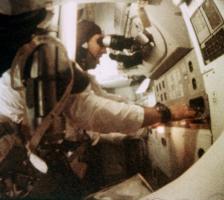
Commander Lovell using the sextant, Apollo 8
Sailors have navigated by the stars since the dawn of time. Now, fifty years after Neil Armstrong first set foot on the Moon in the Apollo 11 mission, we shouldn’t forget that even the Apollo astronauts relied on sextants to navigate to the Moon and back. Not only did a sextant help to get to the moon, but Astronaut Jim Lovell’s use of a sextant would be instrumental in saving the crippled Apollo 13 in 1970.
The Apollo sextant was a modern update of device that sailors have used for centuries. It played a key role in the three-part navigation system in the Apollo program. Much of the navigation was performed using ground-based radar. When that was not available, an inertial guidance system was used. The inertial guidance system tended to drift however and needed to be corrected periodically. To do so, the astronauts used a scanning telescope and a sextant to take star sights. These sights were used to correct the inertial guidance system and to confirm the accuracy of the ground-based navigation system. The sextant was also considered to be a backup against the possibility that the Russians would attempt to jam radio transmissions between Mission Control and the Apollo spacecraft.
“There are thirty-seven stars – and one is the sun,” said Apollo engineer Jerry Woodfill, “that provided an accurate way of aligning the spacecraft’s computer platform to allow the astronauts to steer their way through the heavens.”
The sextant had different uses during different phases of the missions. As described by Astronomy.com:
The Apollo sextant was used in Earth and lunar orbit, as well as while en route between Earth and the Moon. It played different roles in each of those contexts: in orbit around Earth or the Moon, the sextant could be used to compute the spacecraft’s altitude and position; whereas in transit between Earth and the Moon, it could be used to compute the spacecraft’s attitude (orientation), position, and velocity. A proper attitude during the flight to and from the Moon was critical for accurate course corrections and burns to reach the Moon and correctly insert the spacecraft into the desired lunar orbit. The device was used repeatedly throughout the Apollo program across many phases of the missions, up to and including re-entry.
All the navigators on the Apollo missions used sextants. The most well-known example perhaps was by Commander Jim Lovell, and ex-Navy aviator, whose use the craft’s sextant helped bring the crippled Apollo 13 safely home.
On the previous Apollo 8 mission, Lovell made a mistake entering a star sighting into the onboard computer. The mistake caused the craft to rotate approximately 90 degrees. To reorient the spaceship, Lovell used a novel technique using the Earth’s terminator line. The terminator is the line which delineates between night and day on Earth; where the Sun is shining and where it is dark. It worked to reorient the spacecraft, and Lovell became the only astronaut to have used the technique. Two years later, his experience may have saved his life and that his crew on the Apollo 13 mission.
Two days after launch, an oxygen tank exploded crippling the spacecraft. Short on oxygen and lacking the power to run the inertial navigation system, Commander Lovell needed to plot reentry manually. Because of floating debris from the explosion outside the craft’s window, he couldn’t take star sights with the sextant. So, he relied on his experience on Apollo 8 and used his sextant and the terminator line to plot a safe reentry. Without a sextant and Commander Lovell ‘s unique experience is likely that none of the Apollo 13 crew would have made it home.
In 2006, the US Navy stopped teaching celestial navigation to its officers, relying instead on GPS. A decade later, after concerns about GPS vulnerabilities, the Navy resumed teaching its cadets how to use sextants to find their location at sea, just the Apollo astronauts used sextants to find their way in space.

Watched it as it happened, but local TV news and PBS are driving it into the ground on all channels all darn week!
I’m sick of hearing about it!
Excellent post about sextant use on the Apollo missions. I had no idea. Sure glad our navy started teaching celestial navigation again. There is no good reason not to and every reason to know how to do navigate this way and to have experience taking sights with a sextant and using tables. (Might I suggest to those who are sick of hearing about it that they turn off their TV, buy an inexpensive teaching sextant, and learn the basics.)
This story should have been a great chapter in Dag Pike’s History of Navigation.
This is one detail of space travel I never knew and that’s probably true for most of your blog readers.
Thanks for a 50th anniversary story no one else presented!